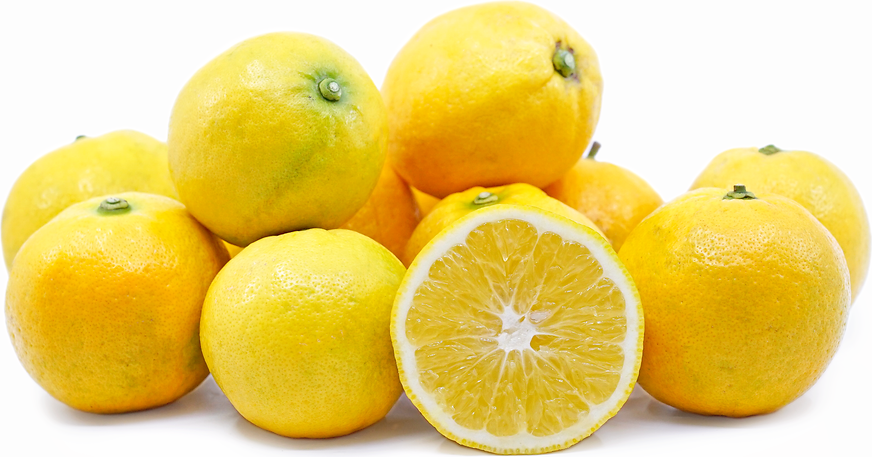


Lemonade Fruit
Estimated Inventory, lb : 0
Description/Taste
Lemonade fruits are a small to medium citrus, averaging 7 to 10 centimeters in diameter, and have a round to oval shape. The rind is glossy, smooth, and lightly textured, covered in small oil glands that release an aromatic, bright citrus scent. When young, the rind is dark green, ripening to a bright yellow with maturity, and underneath the surface, there is a thin layer of semi-sweet, white, spongy pith. The flesh is aqueous, soft, and golden yellow, divided into 9 to 11 segments by thin membranes, and the fruits may either be seedless or contain a few ivory seeds. Lemonade fruits have low acidity, allowing the natural sugars found in the flesh to create a refreshing, sweet, and tangy flavor without the sour taste commonly associated with lemons.
Seasons/Availability
Lemonade fruits are available in the late fall through early spring.
Current Facts
Lemonade fruits, botanically classified as Citrus limon x reticulata, are a sweet hybrid citrus belonging to the Rutaceae family. The fruits are very similar in appearance to lemons and were first discovered growing as a chance seedling in New Zealand in the late 20th century. Lemonade fruits have low acidity, giving the fruits a sweet, tangy flesh that can be consumed straight, out-of-hand. Despite its favorable, fresh eating quality, Lemonade fruits are not commercially grown on a large scale and are mainly cultivated through smaller citrus growers and home gardeners as a specialty variety. The fruits are mostly present throughout Australia and New Zealand, where they are also known as Lemonade Lemons, New Zealand Lemonades, Lemonade Citrus Tree, and Unlemons.
Nutritional Value
Lemonade fruits are a good source of vitamin C to strengthen the immune system and potassium to balance fluid levels within the body. The fruits also contain calcium to strengthen bones and provide lower amounts of fiber and folate.
Applications
Lemonade fruits have a sweet, subtly tangy flavor that can be utilized in a wide variety of fresh and cooked applications. The fruit’s rind can be sliced or peeled, and the flesh can be segmented, consumed straight, out-of-hand. The segmented flesh can also be chopped and mixed into fruit bowls, blended into smoothies, juiced for fresh lemonade, squeezed over guacamole, or used to flavor cocktails as a twist on traditional lemons. In addition to fresh preparations, Lemonade fruit’s juice and zest can be incorporated into baked goods, cheesecake, butter, or meringue, or it can be used to flavor vinaigrettes and sauces. The fruits can also be cooked into marmalades, jams, jellies, and curds, simmered into syrups, or preserved for extended use. Lemonade fruits can be used as a lemon or lime substitute in recipes calling for milder acidity. Lemonade fruits pair well with ginger, herbs such as mint, basil, thyme, and lavender, meats such as poultry, turkey, and fish, other seafood, fruits such as pears, peaches, and coconut, avocado, zucchini, and cucumber. Whole, unwashed Lemonade fruits will keep at room temperature for a few days or stored in the refrigerator for 1 to 2 weeks.
Ethnic/Cultural Info
Lemonade fruits are primarily a home garden cultivar found throughout Australia and New Zealand. The dwarf trees are considered ornamental with their evergreen leaves, fragrant white flowers in the spring, and bright yellow fruits in the winter. Lemonade fruit trees also bear long thorns, used as protection from animal predators, and the variety is highly productive compared to its compact size. In New Zealand, many Kiwis fondly remember eating the fruits straight from the tree in home gardens when they were children, peeling the rind, and consuming the juicy, sweet, and tangy flesh. Lemonade fruits were also commonly chilled, sliced similarly to an orange, and eaten as an afternoon snack. Beyond summer afternoon snacks, the fruits were also a central element in a traditional dinner party prank, challenging guests to bite into a lemon slice, not knowing if it was a tart lemon variety or a wedge of sweet Lemonade fruit.
Geography/History
Lemonade fruits were discovered growing as a natural hybrid in New Zealand in the 1980s. The variety’s parentage is mostly unknown, with experts believing it is a cross between a lemon and a mandarin. Shortly after its discovery, Lemonade fruits were introduced into Australia, where they became a popular home garden variety grown on a small scale. The cultivar was also brought to the United States in 2005 and is regarded as rare, only cultivated through select farms for low commercial production. Today Lemonade fruits are found in subtropical, warm climates throughout New Zealand, Australia, and the Central Valley of California and Florida of the United States and are sold at farmer’s markets, specialty grocers, and online retailers.
Recipe Ideas
Recipes that include Lemonade Fruit. One
| Amy in the Kitchen |
|
Lemonade Crush Smoothie |
| Serious Eats |
|
Rosemary Lemonade Cake |
| Good Food |
|
Lemonade Marmalade |
| Delish |
|
Lemondade Cheesecake |
| The Spruce Eats |
|
Citrus Cooler |

















